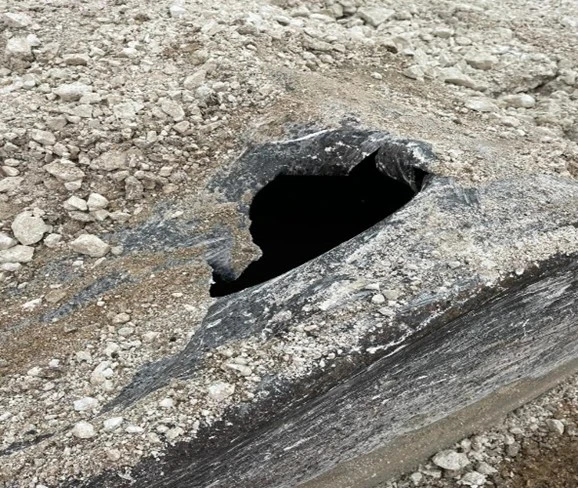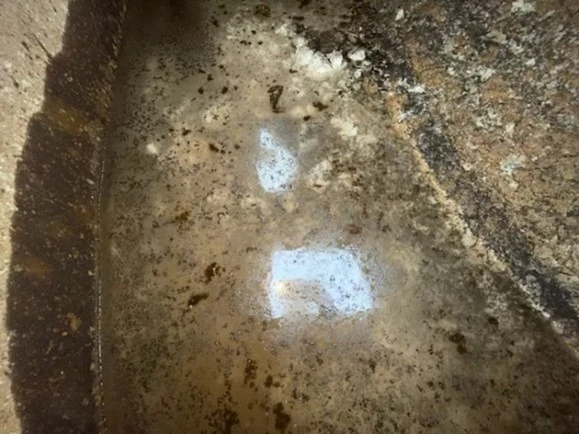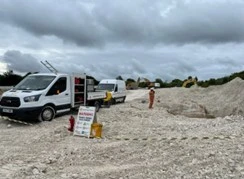The Challenge
Our client, a building development company, contacted Ideal Response following discovery of a historic underground fuel tank. The fuel tank was discovered after on-site machinery hit the top of the tank during landscaping works. The tank was punctured, and an immediate petroleum odour was observed. Thus, indicating the presence of potentially harmful oil spill or water oil contamination. Works in the vicinity were immediately stopped and a control zone was implemented by our client. Correctly our client was concerned about the Health and Safety Explosion risk along with potential environmental impacts.

Building and construction jobs are on strict time frames and budgets. Any potential delays can have a compounding effect on the company. Even a small delay can lead to potentially thousands of pounds in additional costs related to paying labourers. The company will also be liable to pay Liquidated and Ascertained Damages (LADs). These financial implications meant that for our client any length of delay was too much. The problem needed to be dealt with professionally and efficiently.
Unexpected Complications
The challenge we faced for this job was to ensure the area is thoroughly cleaned of any hazardous substances, such as oil, gasoline, or diesel. Upon completion of this task the client would be issued a Gas-Free certificate. This would allow the safe removal of the damaged tank. Another challenge we faced during this job that added further complications to the task was the discovery that the damaged tank had previously and poorly received a concrete infill. The concrete infill was done in attempt to decommission the tank. The poor attempt of this infill would need to be navigated and dealt with by our team to complete the job and remove the con.
Due to the nature of the incident the client was facing, work on the site was ceased because of the safety concerns. They contacted Ideal Response late in the day of a Tuesday, they provided photographs of the incident, however, due to the prominent petroleum odour the images provided had to be taken from a safe distance. This limited the amount of detail that could be provided to our experts. Also it inevitably added some difficulty when creating a solution to the problem. We would be going into the job knowing that upon arrival, we could be faced with additional issues that were impossible to identify beforehand.
The Ideal Solution
These are the sort of challenges that Ideal like!
Our experts created a detailed plan of action that would ensure that the job was completed safely and on time. This plan included the:
- Extraction of the contaminated water
- Use of cold cut methodology to gain access into the tank
- Cleaning of the tank from the inside by a specialist tank entry team
- Analysis and issuance of gas free certificate
- Removal and disposal of the extracted tank contents via a licensed waste facility
First thing on Wednesday morning a specialist Petroleum Uplift Tanker was deployed to site. The hole caused by the original incident was sufficient for us to access the free product and remove. During these works it was observed that the liquid within the tank was a water / petroleum mix rather than product. Water oil contamination is a common occurrence for tanks that had previously been decommissioned / emptied where smaller quantities of petroleum remain. It should be noted that even small volumes of petrol occupying voids (headspace) remain a highly significant hazard.

Once the contents of the tank had been fully removed the total amount of water and petroleum came to three tonnes. A petroleum uplift of this size would only be possible using large scale professional equipment. Our access to such equipment and our ability to carry out the service in the limited time frame made the decision to contact Ideal Response the best option the client could have taken.
Contaminated Liquid Removal
Once the entirety of the liquid had been removed from the tank and the tank had been assessed, a team of fully qualified tank entry specialists began their work. Using cold cut methodology, a cut was made along the length of the tank. Using gas monitors, the tank and surrounding area were checked for Lower and Upper Explosion Limits (LEL / UEL). The range between this limit is known as the flammable range.
Once the cut had been made and works were deemed safe, the tank was effectively peeled open using machinery. This opening allowed our confined space cleaning team to enter the tank via a tripod/winch system. During this portion of the service, the team of specialist were fully equipped with gas monitors and full PPE/RPE. The tank was cleaned from inside and any remaining liquid removed. An additional reading of LEL / UEL was taken and a 72-hour gas free certificate issued to our client. This allowed for the safe removal / excavation of the tank.
The Result
Ideal Response was able to complete the job and render the area safe for the continuation of the construction work. Using a Petroleum Uplift Truck and a team of tank entry specialist we were able to complete the petroleum uplift without the need for any external equipment or professionals. Ideal Response can be relied upon to deal with an issue completely in-house. This allows us to take a direct approach to solving our clients’ issues in the timeliest manner. Showing our ability to do so streamlines communication and guarantees the highest level of professionalism and quality. As shown in this issue, as we completed the entire job in less than 24 hours.

All oil contamination removed from the tank and during the cleaning process was handled and transported to a licensed waste facility for disposal. As licensed upper-tier waste carriers Ideal Response has the means to transport all forms of waste and the access to licensed facilities for disposal.
Ideal Response completed the multifaceted petroleum uplift service in less than twenty-four hours of the initial contact from the client. Our ability to carry out the product removal, tank cleaning and issuance of gas free certification ensured minimal disruption to our client’s schedule. This reduction in down time saved our client potentially thousands of pounds had the delays taken multiple days or potentially weeks. Our client was able to resume construction the following day (Thursday) as the area was now completely safe and a gas free certificate had been provided.



